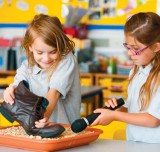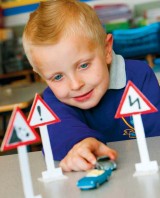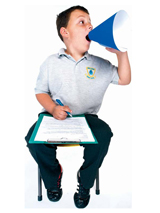Plan a car chase, design movie costumes and create sound effects in this cross curricular unit from the International Primary Curriculum...
The element of surprise is a useful tool for the creative teacher and like many projects in the International Primary Curriculum (IPC), Media Magic begins with an unexpected treat.
The day before the topic begins – once the children have left - your first task is to transform the classroom into a cinema. Windows need to be blacked out, chairs arranged into rows and small bowls of popcorn prepared for the children. A willing member of staff, armed with a torch, should also be prepped for the role of usher. The finishing touch is a set of make-shift curtains for the cinema screen – or interactive whiteboard.
 The next day the children will be delighted to see their new surroundings and, once they have taken their seats, it is time to start the movie. Try to choose a film that is relatively short and uses music or actions to tell the story, rather than dialogue. A perfect example of this is the five-minute short film Dangle. There is no music or dialogue in the film; instead, the story is told through a clever mix of special effects and the actor’s facial expressions. The film is available as a free download at schoolsworld.tv
The next day the children will be delighted to see their new surroundings and, once they have taken their seats, it is time to start the movie. Try to choose a film that is relatively short and uses music or actions to tell the story, rather than dialogue. A perfect example of this is the five-minute short film Dangle. There is no music or dialogue in the film; instead, the story is told through a clever mix of special effects and the actor’s facial expressions. The film is available as a free download at schoolsworld.tv
After the viewing, discuss the film as a whole class. Encourage the children to talk bout what they liked about the story and how it was communicated without the use of dialogue. Revisit key moments and focus on the facial expressions.
The session should end with a mystery phone call. (You will need to arrange this prior to the session, asking another member of staff to phone at the allotted time.) Take the call and act surprised, as if you have just received some very good news.
Explain that the caller was the head of ‘International Studios’. They make films and television programmes for the whole world. The head of the studios has asked your permission to allow the children to help out on the films and television programmes that the studio is making.
In the IPC, this is known as the ‘entry point’ and is used to set the scene and enthuse the children about the learning that follows. And in the case of Media Magic, the children will be getting to grips with an age of instant information and rapid communication by working for the fictional International Studios. It’s a project that both provides an entertaining and culturally relevant premise and gives children an internal perspective on the media and communications industry. What’s more, as the following activities demonstrate, it’s a theme that can easily be applied to all areas of the curriculum.
 Prior to the lesson, you will need to collect a series of everyday objects, instruments and materials for creating sound effects.
Prior to the lesson, you will need to collect a series of everyday objects, instruments and materials for creating sound effects.
When the children enter the classroom, allow time for them to investigate the strange selection. Ask them to suggest what the items might be used for.
Watch a clip from a film that the children may be familiar with. Choose a segment of film that has lots of examples of movement and noise.
Afterwards, ask the children to talk about the sounds they remember hearing in the clip. As well as the actors’ speech, focus on other incidental sounds such as footsteps, opening doors, the rustle of clothes, weather effects and so on.
Explain the role of the Foley artist. Nearly all of the sounds we hear in a film or a television programme are added afterwards in a studio. This is because it is impossible for a microphone to pick up all the necessary sounds during filming. Look on YouTube for an example of a Foley artist in action and show this to the class.
Now watch your film clip again. Using the objects provided, invite the children to experiment in reproducing some of the sounds they heard in the film clip, such as the crackling fire, the booted feet, the clink of chains and so on.
Get practical
At this point, the children are told that International Studios’ Foley artist is sick and they are being asked to help produce sound effects for a selection of new films.
Divide the class into groups and give each a movie card and a selection of ‘sound effects’ objects. Include more items than the children will need so they can experiment and decide on the most appropriate ones to use. The movie card should give a very simple description of a scene. For example:
• A group of children exploring a haunted house
• A knight rescuing a princess from a witch’s tower
• A group of animals looking for shelter from a storm
In their groups, the children should talk through and plan what will happen in their scene. Encourage them to make a simple list of actions and events, and then think about how they will use sound effects to communicate their story. Some members of the group can play the actors/characters and mime out the story for the rest of the group to match their sound effects to. Invite each group to perform to the rest of the class.
 Tell the children that International Studios would like them to take on the role of costume designers on a major new film.
Tell the children that International Studios would like them to take on the role of costume designers on a major new film.
Ask the children to think about how the clothes we wear can communicate something about us. For example, look at the uniforms or clothing that the children are wearing. What does this uniform communicate to other people? What is it about the uniform that says we belong to a group?
Encourage the children to reflect on the clothes other people wear. Can we sometimes tell what job someone does because of what they are wearing? Consider uniforms for jobs in the fire and police service, hospitals, offices and so on.
Look at some clips from films the children may already be familiar with. In each clip, ask the children to look at the costumes of the characters and discuss afterwards how the character’s dress and appearance communicated something about their personality (choice of dress, dominant colours, wear and tear, accessories and so on).
Good character examples to look at include:
• The White Witch from The Chronicles of Narnia: The Lion, The Witch and The Wardrobe (Walt Disney Pictures, 2005)
• Cruella De Vil from 101 Dalmatians (Walt Disney Pictures, 1996)
• Clark Kent/Superman from Superman (Alexander Salkind, 1978)
Get practical
Working in pairs or small groups, provide the children with collage and art materials. Offer a selection of characters for the children to choose from (for example, a fairy godmother, a traveller from the future, an explorer, a wizard, an evil princess and so on) and challenge them to design their chosen character’s costume.
Provide paper for the children to draw an outline of their character. Then let the children create their costumes using the materials provided. Encourage them to explore different colours and textures, and how they can shape materials to give them more character. Allow time at the end of the session for the children to present their characters and talk about their design. Are there any elements of their design that they want to change/improve?
 Tell the children that International Studios has tasked them with developing a car chase for a major new film. Like most work that is done on films, the children will be creating a model set to capture the action of their exciting chase scene.
Tell the children that International Studios has tasked them with developing a car chase for a major new film. Like most work that is done on films, the children will be creating a model set to capture the action of their exciting chase scene.
Begin by asking the children to think about what they will need to do to make their chase as realistic as possible. Like the model/set builders that work on real films, they will need to research their local area in order to create a set that looks authentic.
Take the children on a walk around the local area. Ask them to record the examples of street furniture (post boxes, sign posts, traffic lights, shop signs, market areas, bus lanes and so on). Use photography to record the children’s observations.
Back in the classroom, view the photographs and talk about the children’s findings. Focus on the street signs and discuss their function. Are they meant for pedestrians, drivers, or both? How do these signs use colour and shape to communicate a message? Look at as many different examples as you can. Work together to sort the signs into groups. For the children’s chase scene, they will need to think about these elements to make their scene look as realistic and believable as possible.
Provide groups of children with large sheets of paper and pencils/crayons, and invite them to work together to create a map layout for their road chase. Include small world vehicles to give a sense of scale. The children’s layout can be purely fictional or could be based on the road layout of their local area. Remind them, when designing their map, to think about the elements that will make their chase more exciting. For example, one way streets, bridges, levelcrossings, multi-lane traffic, junctions and so on. What signs/warnings will these areas need?
Get practical
Provide each group with collage and art materials to make their street set. Buildings and signs can be either three-dimensional models or simply drawn onto the flat map. Ask the groups to present their learning, showing the route of the car chase and the elements that will make it exciting for the viewers.
 End your unit and celebrate your children’s learning with your version of the Academy Awards! Beforehand, provide children with special invitations (in gold or sparkly envelopes) to get them suitably excited. The invitation should also extend to family and friends. During your awards show, allow time for groups of children to talk about a specific piece of the work they have done over the course of the unit. You may want to rehearse this beforehand and be on hand to prompt if necessary. Between presentations, your master of ceremonies can announce the winners of various studio awards. These will be based on different tasks completed by the children. If possible, try to ensure that every child gets to enjoy an award, even if it means awarding one category to a larger group.
End your unit and celebrate your children’s learning with your version of the Academy Awards! Beforehand, provide children with special invitations (in gold or sparkly envelopes) to get them suitably excited. The invitation should also extend to family and friends. During your awards show, allow time for groups of children to talk about a specific piece of the work they have done over the course of the unit. You may want to rehearse this beforehand and be on hand to prompt if necessary. Between presentations, your master of ceremonies can announce the winners of various studio awards. These will be based on different tasks completed by the children. If possible, try to ensure that every child gets to enjoy an award, even if it means awarding one category to a larger group.
The activities in this ar ticle are part of the much larger Media Magic unit from the International Primary Curriculum – just one of 73 projects based around themes of real interest to children. The IPC is a comprehensivecurriculum committed to improving learning and developing international-mindedness. It focuses on developing knowledge, skills and understanding of subjects set within childfriendly, relevant and cross curricular units of learning.
For more information about the International Primary Curriculum, or to visit an IPC school in your area please contact 020 7531 9696 or email .(JavaScript must be enabled to view this email address)
Kindness is contagious - give your colleagues a boost by recognising their efforts
Ace-Classroom-Support
Behaviour management: choosing the right words
Behaviour Management
